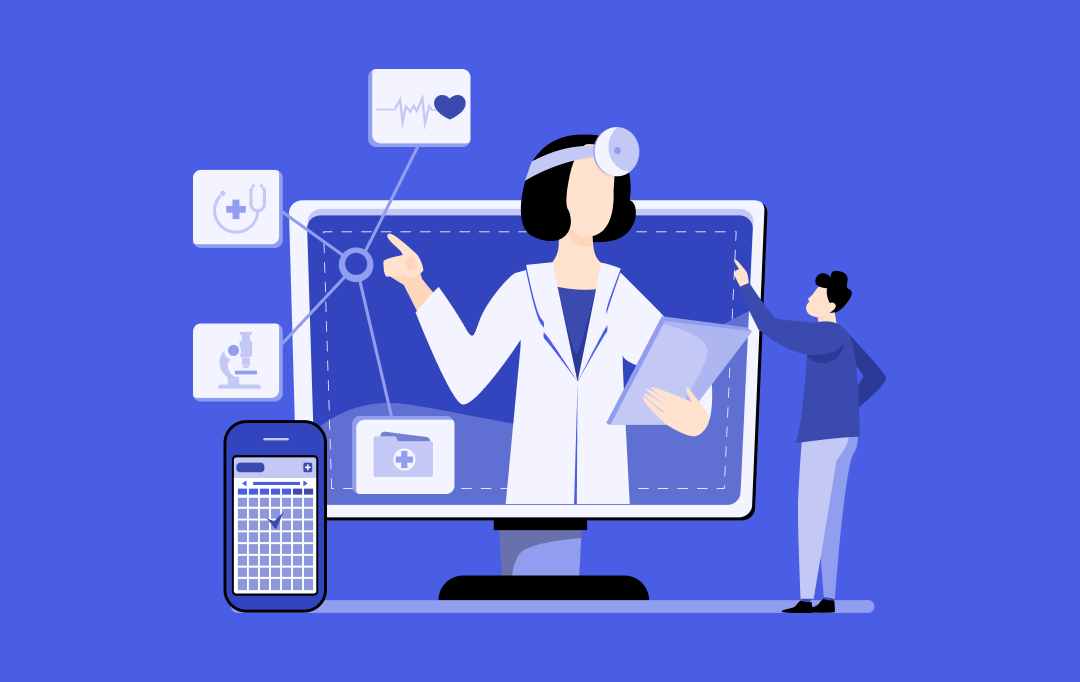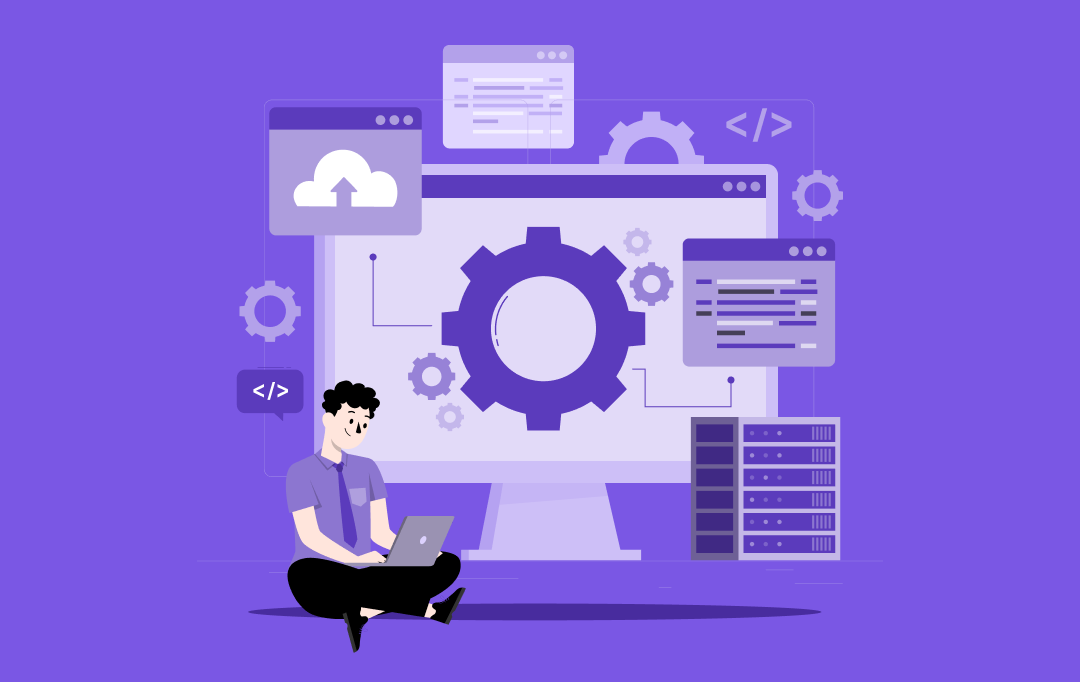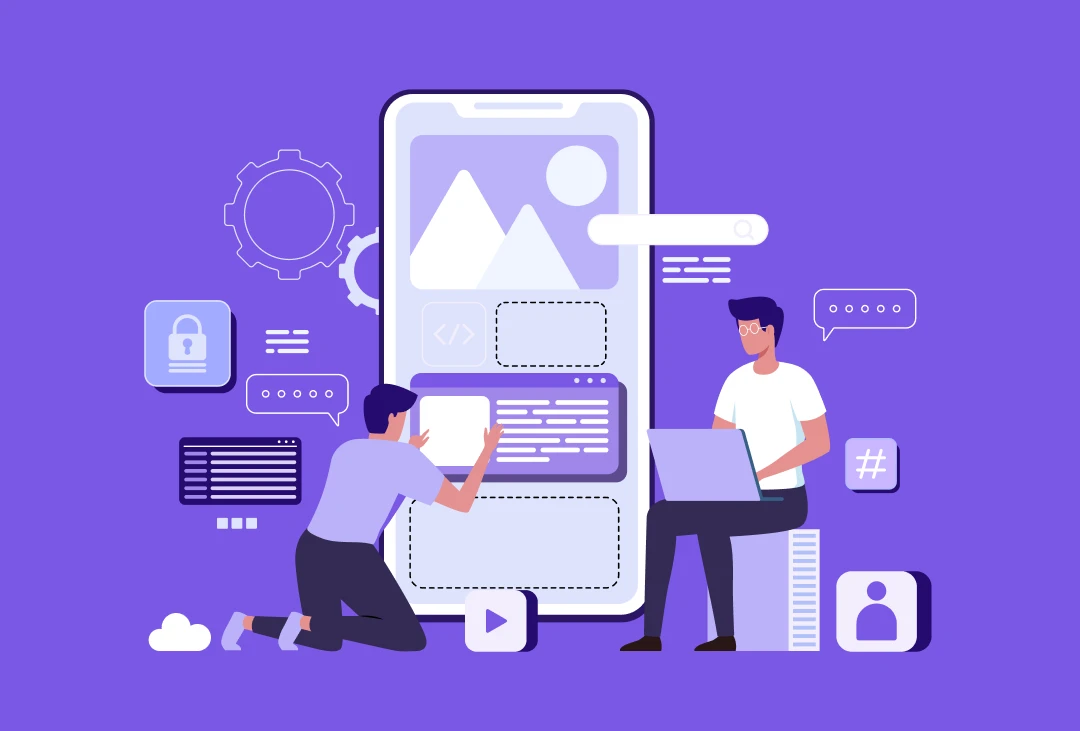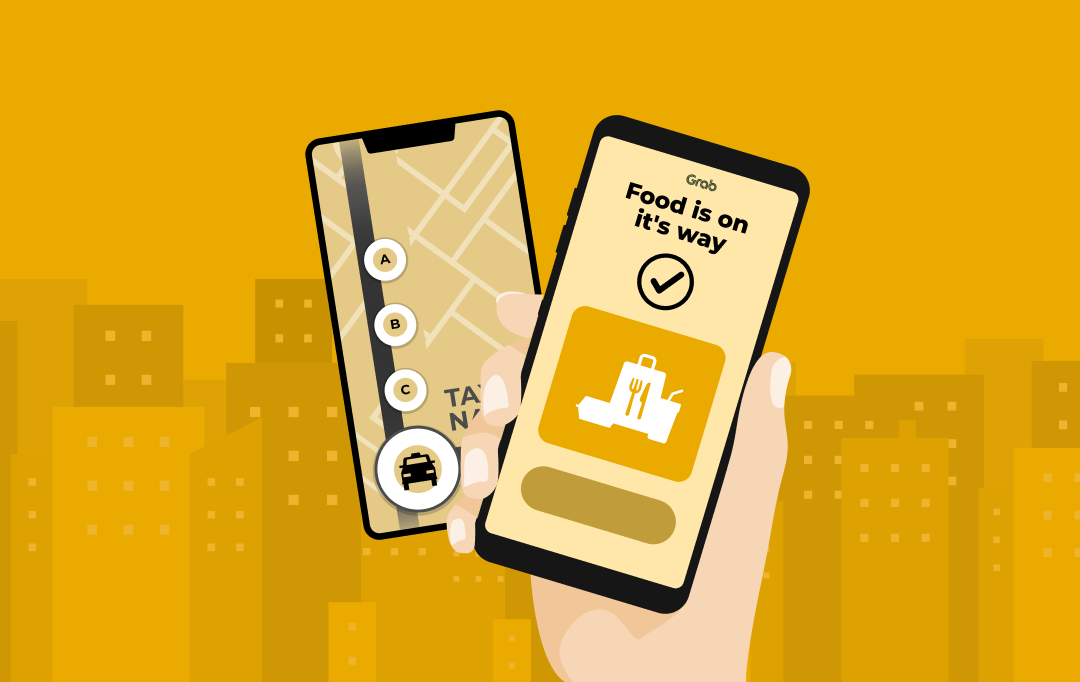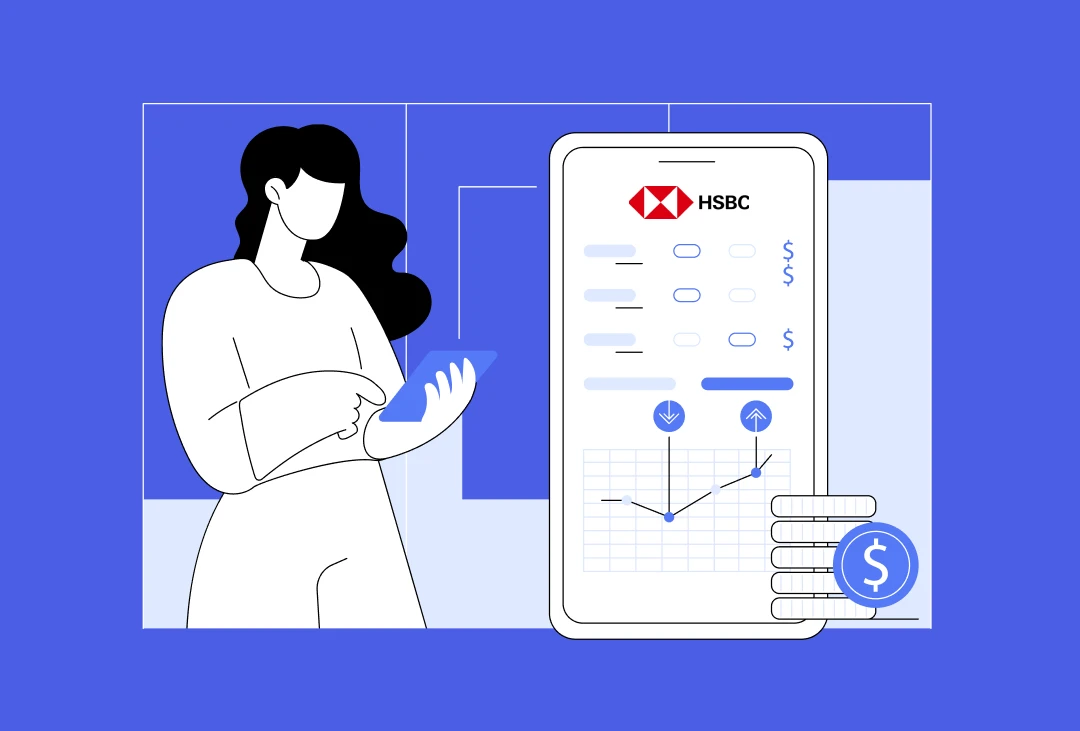What if grocery shopping didn’t mean navigating crowded aisles or waiting in long queues? In Australia, grocery apps are revolutionizing how people shop, offering the convenience of having essentials delivered right to their doorsteps with just a few taps.
This shift presents a lucrative opportunity for businesses to connect with digitally-savvy consumers while gaining advantages like streamlined processes, improved sales, and stronger customer relationships.
But before diving into this promising market, one key question remains—how much does it cost to build a grocery app in Australia? Let’s uncover the answer.
The cost to build a grocery app like Coles typically ranges between AUD 40,000 and AUD 300,000, depending on the app’s complexity, features, platform, and design.
Elements like integrating advanced features, ensuring a seamless user experience, and maintaining robust security standards significantly influence the budget.
So, how can you build a grocery app that stands out in the Australian market? Let’s explore this journey in detail.
Coles Grocery App: Revolutionizing the Shopping Experience
The Coles app offers a seamless grocery shopping experience with innovative features like the in-store aisle finder, barcode scanner, and shared shopping lists, enabling users to shop efficiently and collaboratively.
- Its Click & Collect with Direct to Boot option lets customers notify the store en route, ensuring groceries are delivered directly to their car.
- The app provides weekly catalogs; personalized fly buy offers, and unit price sorting for cost-effective shopping.
- New users enjoy perks like free delivery on their first $100+ order and $10 off their first Click & Collect purchase.
In 2024, the app contributed to a 44.1% rise in monthly active users and drove e-commerce sales to approximately 3.7 billion AUD, with online sales making up 9.3% of Coles’ total sales in Q3. With features like meal planning and growing popularity, the Coles app has become a key player in Australia’s digital grocery market.
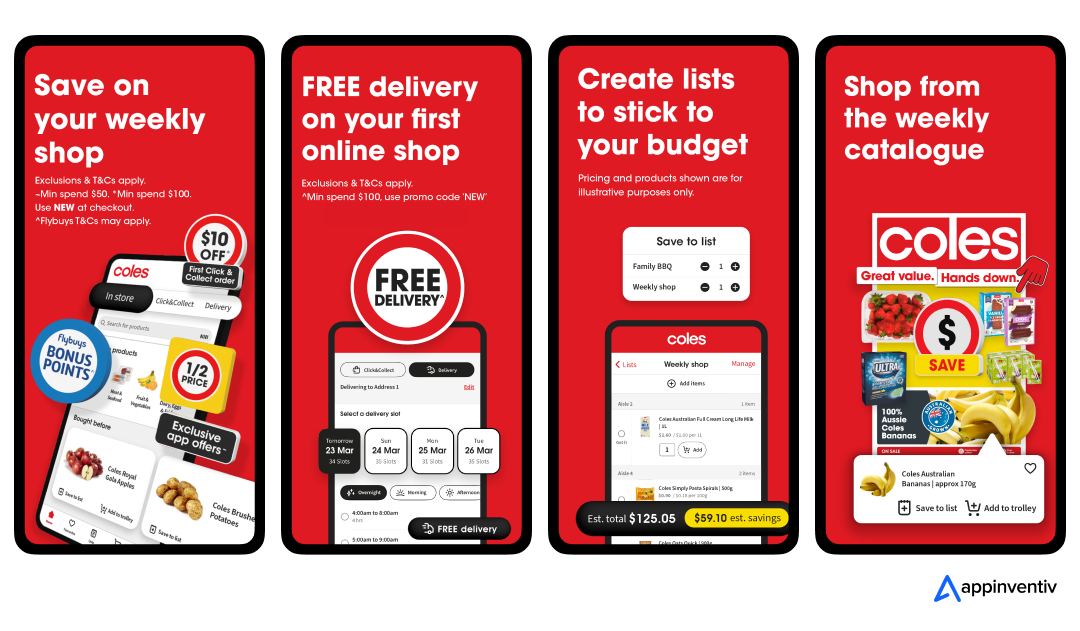
How Much Does It Cost To Develop An App Like Coles
The cost to build a grocery app like Coles can range from AUD 40,000 to AUD 300,000, depending on features, design complexity, and platform choice (iOS/Android).
Key cost factors include product catalog management, payment gateway integration, real-time inventory updates, and delivery tracking.
Additional maintenance, regular updates, and scalability expenses must also be considered. To get an accurate cost estimate, working with experienced app developers to define your app’s specific features and requirements is essential.
| App Complexity Levels |
Features |
Duration |
| Basic
($40,000 to $60,000) |
1. Simple UI
2. Basic Navigation
3. Limited Functionality
4. Standard Security Measures
5. Basic Database Integration
6. Essential Push Notifications
7. Single Platform Compatibility (iOS or Android) |
2 to 4 months |
| Moderate
($60,000 to $120,000) |
1. Enhanced UI
2. Improved Navigation Experience
3. Expanded Functionality
4. Enhanced Security Features
5. Integration with External APIs
6. Basic Offline Functionality
7. Cross-Platform Compatibility
8. Social Media Integration |
4 to 6 months |
| Complex
($120,000 to $300,000) |
1. Highly Polished UI/UX Design
2. Advanced Navigation Features
3. Rich Functionality with Custom Features
4. Robust Security Protocols
5. Seamless Third-party Integrations
6. Advanced Offline Capabilities
7. Real-time Updates
8. Advanced Analytics and Reporting
9. Multi-language Support
10. Cross-Device Compatibility |
6 to 9 months |
A Simple Formula to Estimate the Cost of Developing a Grocery App
The cost to build a grocery app like Coles is typically determined by two main factors: the number of development hours required and the hourly rate charged by the development team. A straightforward formula can help you calculate the overall cost of creating a grocery app.
| Development Hours × Hourly Rate = Total Cost |
Factors That Influence the Cost of A Grocery App
Here are some valuable factors that impact the cost of developing a grocery app. Understanding these elements will help you plan your budget and development strategy effectively. Considering these factors, you can make informed decisions to optimize cost and functionality.
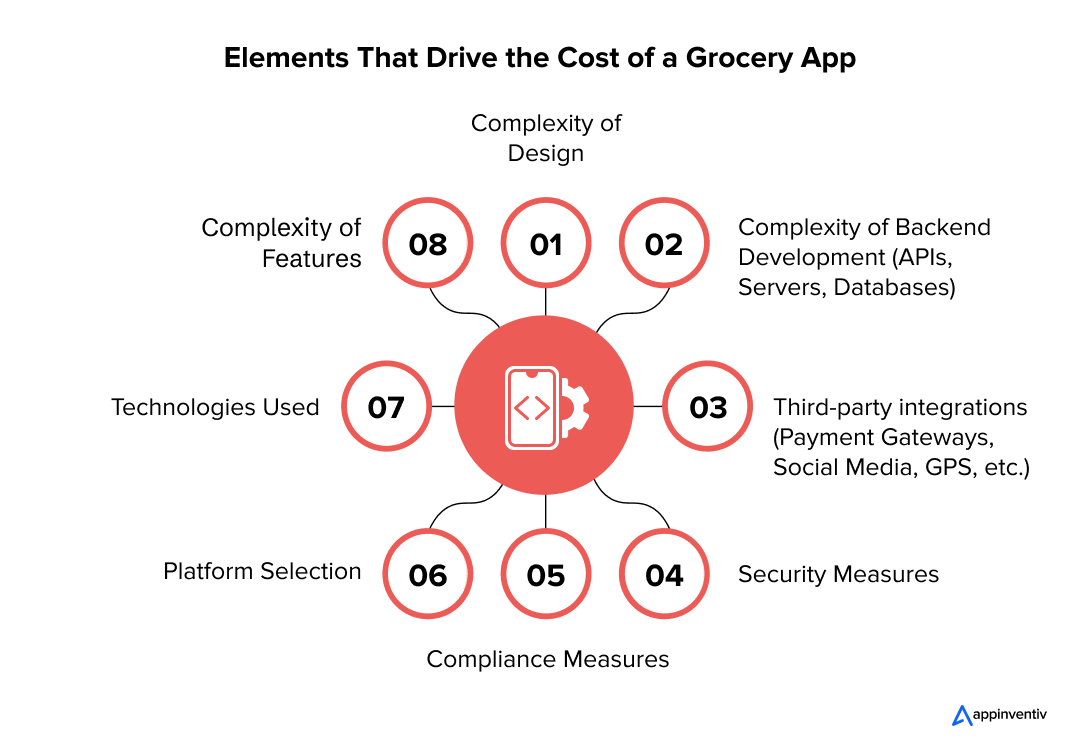
Complexity of Design
The complexity of the design plays a significant role in the cost of development. A user-friendly, visually appealing, and intuitive interface requires a skilled design team, which adds to the overall cost. Custom animations, detailed graphics, and brand-specific designs increase the cost of grocery app development.
- Basic UI/UX Design: $6,000 – $30,000
- Custom/Advanced UI/UX Design: $30,000 – $50,000+
Complexity of Backend Development (APIs, Servers, Databases)
A robust backend infrastructure is essential for handling large user bases, real-time data, and inventory management. The more complex the database and server architecture (including APIs for payment processing, delivery tracking, etc.), the higher the grocery app development cost.
- Simple Backend: $5,000 – $15,000
- Medium Complexity Backend: $15,000 – $40,000
- High Complexity Backend: $40,000 – $100,000+
Third-Party Integrations (Payment Gateways, Social Media, GPS, etc.)
Integrating third-party services such as payment gateways (Stripe, PayPal), social media logins, and GPS tracking systems for delivery increases the development time and grocery delivery app development cost. Each integration requires thorough testing and maintenance, adding complexity to the project.
- Basic Integration (Single Payment Gateway): $2,000 – $10,000
- Complex Integration (GPS, Multiple APIs, Real-Time Analytics): $5,000 – $15,000+
Security Measures
To ensure user data protection and secure transactions, implementing advanced security measures such as data encryption, two-factor authentication, and compliance with privacy regulations (e.g., GDPR) will add to the development grocery delivery app development cost.
- Basic Security Measures (SSL, Data Encryption): $5,000 – $8,000
- Advanced (Biometrics, Multi-Factor Authentication, Encryption): $15,000 – $100,000+
Compliance Measures
Adhering to local and international regulations related to e-commerce, data protection, and consumer rights requires compliance measures to be built into the app. This may involve legal consultations, ensuring security certifications, and auditing.
- Basic Compliance Features: $15,000 – $30,000
- Advanced Compliance (industry-specific): $30,000 – $100,000+
Platform Selection
Whether to build the app for iOS, Android, or both affects the development cost. Cross-platform development frameworks like React Native or Flutter are cost-effective but may have limitations compared to native app development, which can be more expensive but offer superior performance.
- Single Platform (iOS or Android): $30,000 – $100,000
- Cross-Platform (iOS and Android): $100,000 – $300,000+
Technologies Used
The choice of technologies (e.g., programming languages, frameworks, cloud services) significantly impacts grocery app development cost. Advanced technologies like AI-driven recommendations, augmented reality, or advanced analytics can elevate the app’s complexity and cost.
- Basic Tech Stack (React Native, Flutter, PHP): $50,000 – $120,000
- Advanced Tech Stack (Python, AI, Blockchain): $120,000 – $250,000+
Complexity of Features
Features like real-time inventory management, push notifications, personalized shopping experiences, and loyalty programs add to the app’s functionality and overall grocery delivery app development cost. The more advanced the features, the more time and resources are required to develop and maintain them.
- Basic Features (Account setup, Secure logins, balance tracking): $30,000–$50,000
- Advanced Features (AI investment advice, real-time analytics): $100,000–$200,000
Disclosing the Hidden Cost to Develop a Grocery App
Businesses often encounter hidden costs during grocery mobile app development beyond the initial estimate. These can include expenses for app maintenance, third-party integrations, and unforeseen customizations. Understanding these hidden costs upfront is essential to avoid budget overruns.
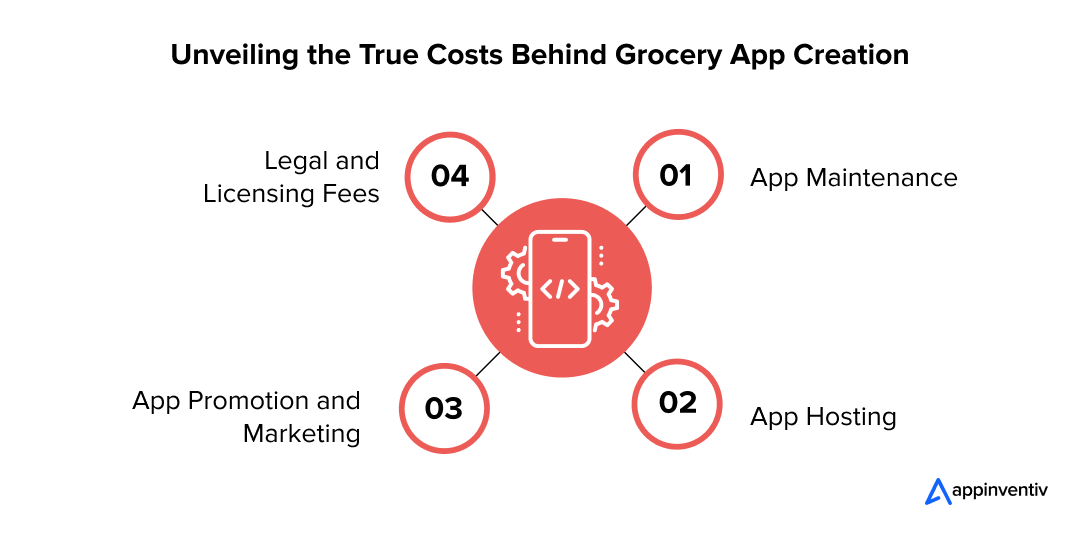
App Maintenance
Regular updates, bug fixes, and ensuring compatibility with the latest operating systems are crucial for maintaining a seamless user experience. Neglecting app maintenance can lead to performance issues and decreased user retention, making it an ongoing cost to consider.
Action Points:
- Schedule regular updates to improve performance and introduce new features, saving cost to build a grocery app like Coles.
- Monitor user feedback to identify and fix bugs promptly.
- Ensure compatibility with new operating system versions and devices to minimize the cost to build a grocery app like Coles.
App Hosting
Hosting your app on cloud platforms or servers incurs monthly or yearly grocery delivery app development cost. The cost depends on the server capacity, scalability requirements, and volume of user data processed and stored.
Action Points:
- Choose a scalable cloud platform that accommodates your app’s growth.
- Estimate server capacity based on expected user traffic and data storage needs.
- Regularly review hosting plans to ensure cost-effectiveness and performance.
App Promotion and Marketing
A grocery mobile app development needs consistent visibility to attract and retain users. Marketing expenses include paid ads, social media campaigns, SEO optimization, influencer collaborations, and promotions to drive app downloads and engagement.
Action Points:
- Develop a strategic marketing plan, including SEO, social media, and influencer partnerships.
- Allocate budget for paid advertising campaigns to boost app visibility and saves cost to build a grocery app like Coles.
- Track and analyze user engagement metrics to optimize ongoing marketing efforts.
Legal and licensing fees
Compliance with regional laws, securing necessary licenses, and ensuring user data protection (e.g., GDPR, CCPA) often require legal expertise. Additionally, obtaining permissions for payment gateways, third-party integrations, or partnerships may incur extra fees. These are essential costs to ensure your grocery app operates within legal frameworks and avoids potential liabilities.
Action Points:
- Consult with legal professionals to ensure local regulations (GDPR, CCPA) compliance.
- Obtain necessary licenses for payment gateways and third-party integrations.
- Regularly reviewing legal requirements to prevent any future compliance issues minimizes cost to build a grocery app like Coles.
How to Optimize App Development Cost Like Coles
Businesses can effectively manage costs by adopting strategic approaches such as prioritizing essential features, leveraging reusable code, and outsourcing development to experienced teams. Coles grocery shopping online focuses on efficiency and scalability serves as a great example for optimizing grocery app budgets.
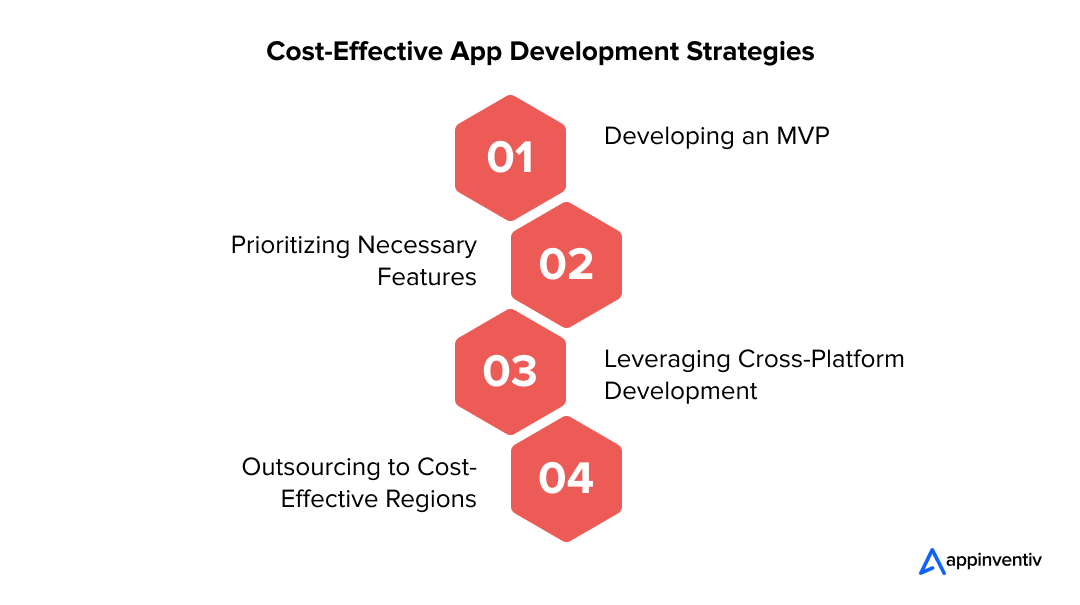
Developing an MVP
Start with a Minimum Viable Product (MVP) to launch your app with core functionalities. This approach reduces initial costs, allows for quick market entry, and provides valuable feedback for further development.
Quick Tips
- Focus on core functionalities that meet user needs and test market demand, saves grocery delivery app development cost.
- Launch with a basic version and iterate based on real user feedback by saving cost to build a grocery app like Coles.
- Set a clear roadmap for future enhancements based on initial MVP success, minimizes development cost of a grocery delivery app.
Prioritizing Necessary Features
Avoid feature overload by focusing on what adds the most value to your target audience. Clearly define your app’s purpose and prioritize essential features to streamline development time and costs.
Quick Tips
- Identify the features that directly solve problems for your target audience saves development cost of a grocery delivery app.
- Avoid adding unnecessary features that could delay development by minimizing cost to build a grocery app like Coles.
- Continuously validate feature relevance through user research and feedback.
Leveraging Cross-Platform Development
Opt for cross-platform frameworks like Flutter or React Native to create a single app that works seamlessly on both Android and iOS. This approach saves development time, reduces costs, and ensures a wider reach.
Quick Tips
- Choose frameworks like Flutter or React Native to build apps for both iOS and Android.
- Focus on reusable code to speed up development and reduce costs.
- Prioritize user experience across both platforms to ensure consistency while prioritizing on demand grocery delivery mobile app development.
Outsourcing to Cost-Effective Regions
Partnering with developers from cost-effective regions can significantly lower expenses without compromising quality. Look for companies with proven expertise and transparent communication to maximize your budget.
Quick Tips
- Choose regions with strong development expertise but lower labor costs.
- Vet outsourcing partners based on their previous work and transparency, prioritize on demand grocery delivery mobile app development.
- Maintain clear communication and set milestones to ensure high-quality delivery by reducing cost to build a grocery app like Coles.
Best Approach to Create An App Better Than Coles
Let’s understand the best approach to develop a grocery app better than Coles. By exploring the steps to make an app like Coles, we can craft a solution that mirrors its efficiency and stands out with superior features and enhanced user experiences. But what exactly goes into the working of an app like Coles? Let’s discover in detail!
Intuitive UI/UX
The design should prioritize ease of navigation, allowing users to find and purchase items quickly. Simple, minimalistic layouts with clear categories ensure a seamless experience. Personalization is key: tailor product recommendations based on user behavior. Features like voice search and an efficient checkout process will keep users engaged. Accessibility, including voice navigation and screen reader compatibility, will ensure the app serves a wide audience.
Here are some prominent grocery app development key features:
User-Side Features
User Registration & Login: Users can create an account using email, phone, or social media and log in securely with OTP or passwords for a hassle-free experience.
Profile Management: Easily update personal details, manage delivery addresses, and set shopping preferences to streamline future orders, showcasing the future of grocery app development like Coles in enhancing user convenience.
Advanced Search & Filters: A powerful search bar with filters like category, price, brand, or dietary preferences (e.g., vegan, organic) makes finding products effortless.
Product Browsing: Users can view detailed product information, including descriptions, images, and nutritional values, for informed purchasing.
Shopping Cart & Wishlist: Manage cart items before checkout or save products in the wishlist for later purchases, simplifying the shopping process.
Scheduled Deliveries: Users can select a convenient delivery slot for their orders, ensuring timely and hassle-free product delivery.
Real-Time Order Tracking: This is one of the best grocery app development key features that allows users to track orders in real time with updates on dispatch, transit, and estimated delivery times.
Multiple Payment Options: Users can choose from payment methods like credit/debit cards, UPI, net banking, mobile wallets, or cash on delivery.
Offers & Discounts: Exclusive deals, promo codes, and loyalty rewards are available to encourage repeat purchases and enhance user satisfaction.
Ratings & Reviews: Users can provide feedback on products and services, helping improve the overall shopping experience.
Admin-Side Features
Admin Dashboard: A centralized dashboard provides an overview of key metrics, such as sales, orders, and customer activity, for better decision-making.
Product Management: Add, edit, or remove products with detailed descriptions, images, and pricing to maintain an up-to-date catalog.
Order Management: View and manage all incoming orders, update their statuses, and ensure timely delivery.
Customer Management: Access customer profiles, manage queries or complaints, and provide support to enhance satisfaction by focusing grocery store app development.
Inventory Management: Monitor stock levels in real-time and set alerts for low inventory to ensure consistent availability.
Payment Management: Oversee all transactions, process refunds, and resolve payment-related issues securely and efficiently.
Delivery Tracking: Assign delivery personnel, track their routes, and optimize delivery times for a smooth logistics process.
Offers & Discounts Management: Create and manage promotional campaigns, coupons, and discounts to boost sales and customer engagement.
Analytics & Reports: Generate detailed reports on sales, revenue, and customer behavior to identify trends and improve operations, focuses grocery store app development.
Notification Management: Send push notifications, emails, or SMS updates for promotions, order confirmations, or delivery updates to keep users informed.
Advanced Features
Incorporating advanced features like real-time inventory updates and dynamic pricing ensures users always have the latest product availability. AI-driven product recommendations will tailor suggestions to shopping habits. Implementing smart shopping lists and reorder options encourages repeat business. Delivery flexibility, such as same-day delivery and order tracking, will enhance convenience.
Robust and Scalable Technologies
Leveraging cloud-based infrastructure like AWS or Azure ensures scalability and data reliability, while microservices architecture allows flexibility. Real-time data processing is crucial for features like live order tracking. Security is paramount, so integrating encryption, secure payment gateways, and multi-factor authentication will protect customer data. AI and machine learning technologies can optimize delivery routes and personalize shopping experiences.
Step By Step Guide to Develop an App Like Coles
Let’s explore the step-by-step guide to developing an app like Coles, a leading grocery delivery service. This guide will break down the essential phases of the app development process, from concept to launch, ensuring you create a seamless and user-friendly app tailored to your business needs.
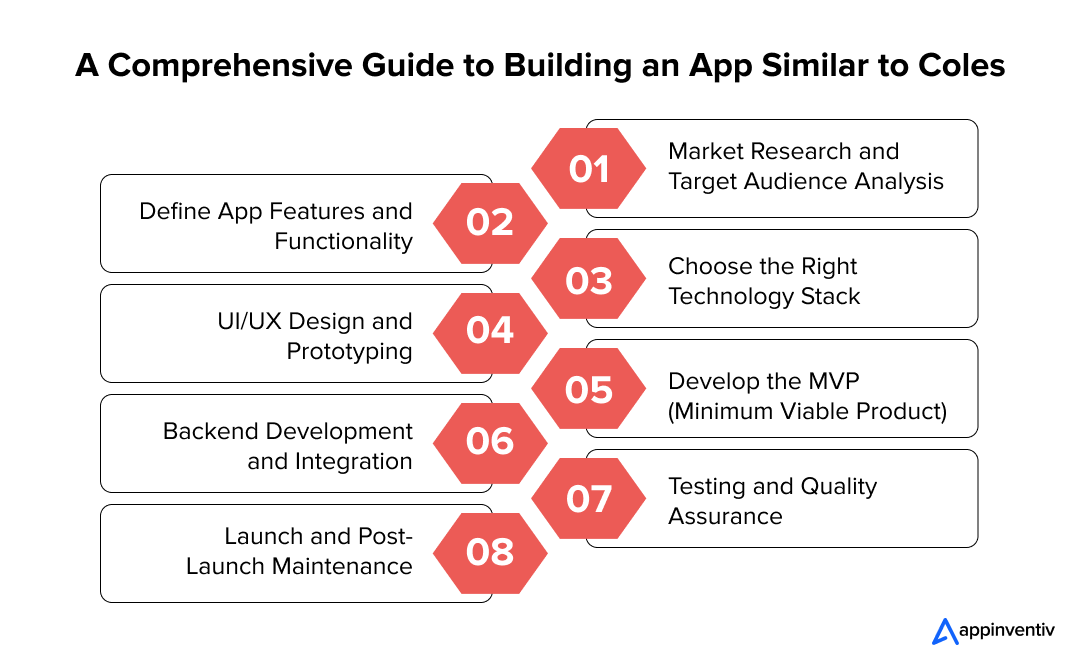
Market Research and Target Audience Analysis
Understand the grocery delivery market size and analyze competitors like Coles. Identify users’ pain points, such as seamless navigation, personalized recommendations, or flexible delivery options, to ensure your app addresses their needs effectively. Conduct surveys or interviews with potential users to gather real-world insights that can shape your app’s unique value proposition.
Define App Features and Functionality
List essential features like product search, online payments, delivery tracking, loyalty programs, and push notifications. Ensure these features provide value to users and enhance their shopping experience. Consider adding advanced options like voice search or AI-driven product recommendations to stand out in the competitive market.
Choose the Right Technology Stack
Select a robust technology stack, including frontend, backend, and databases frameworks. For instance, Flutter or React Native can be used for cross-platform development and secure payment gateways like Stripe or PayPal for transactions. Additionally, ensure scalability by incorporating cloud solutions like AWS or Google Cloud for seamless performance as your user base grows.
UI/UX Design and Prototyping
Create an intuitive and user-friendly design with a clean interface. Focus on smooth navigation, visually appealing product catalogs, and an easy checkout to ensure a seamless shopping journey. Use wireframes and interactive prototypes to visualize the user journey and gather feedback before finalizing the design. This approach saves the cost to build a grocery app like Coles.
Develop the MVP (Minimum Viable Product)
Start with an MVP with core features like user registration, product catalog, and checkout. Launch the app with basic functionality to gather feedback and refine the product before scaling it. This approach allows you to validate your idea in the market while minimizing initial development costs and demonstrating the benefits of grocery app development like Coles.
Backend Development and Integration
Build a scalable and secure backend to handle large user data. Integrate APIs for real-time inventory management, payment processing, and delivery tracking to ensure smooth functionality. Incorporate encryption protocols and authentication systems to protect sensitive user data and ensure compliance with industry standards.
Testing and Quality Assurance
Perform rigorous testing to identify and fix bugs or glitches. Test the app for performance, security, usability, and compatibility across various devices and operating systems to ensure a flawless user experience. Involve beta testers to simulate real-world scenarios and refine the app before launch.
Launch and Post-Launch Maintenance
Deploy the app on app stores with optimized descriptions and visuals. After launch, provide regular updates, monitor user feedback, and continuously improve the app to meet user expectations and stay competitive. Invest in marketing strategies like in-app promotions and social media campaigns to increase engagement and retention.
How to Monetize Apps Like Coles: Effective Strategies
A grocery app like Coles typically employs several monetization strategies, such as offering premium subscriptions for exclusive deals, promotions, and faster deliveries. Additionally, revenue is generated through partnerships with local suppliers and brands, earning commissions on product sales. Let’s explore in detail!
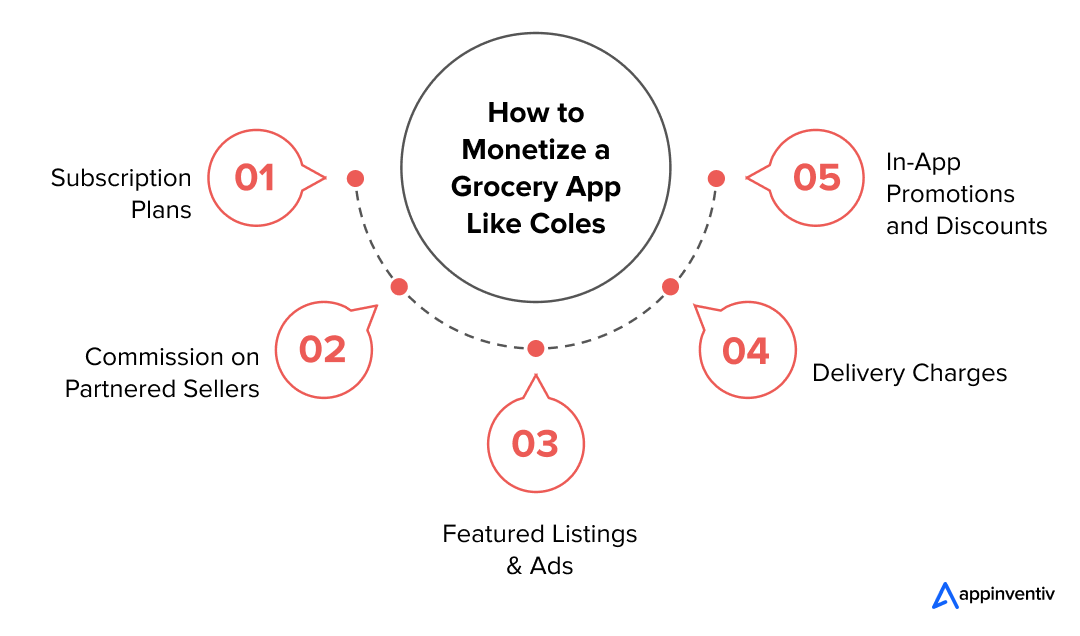
Subscription Plans
A subscription-based model allows customers to pay a recurring fee for premium services, which can include benefits like unlimited deliveries, exclusive discounts, or priority customer support.
For example, a grocery app could offer a “Premium Membership” where users pay a monthly or annual fee for perks such as free delivery on orders, access to special promotions, and early sales notifications. This model ensures consistent, predictable revenue through recurring payments.
Commission on Partnered Sellers
In a commission-based model, the app partners with local grocery stores, farmers, or third-party vendors and charges them a commission for each sale made through the platform. Every time a customer purchases a product listed by one of these partners, the app takes a percentage of the transaction.
For instance, a 10-20% commission on each sale ensures consistent revenue generation while aligning with the app-like Coles working model, which creates a thriving marketplace for smaller vendors.
Featured Listings & Ads
The app can generate additional revenue by offering brands and vendors the opportunity to pay for featured listings or advertisements. Brands looking to increase their visibility can pay a premium to have their products appear at the top of search results, on the homepage, or in other prominent app sections.
For example, a snack company may choose to pay for a spot on the app’s “Recommended Products” section during a holiday sale.
Delivery Charges
Charging customers a delivery fee is a straightforward yet effective monetization model. You can implement a system where users pay for deliveries if their order is under a certain amount or offer faster delivery options for an extra fee.
For example, a grocery app might charge a flat delivery fee of $5 for orders under $50 or a premium for same-day delivery. This helps cover logistics costs and creates an additional revenue stream.
In-App Promotions and Discounts
In-app promotions and discounts are an effective way to generate revenue while attracting customers to purchase more frequently. Brands or vendors can partner with the app to run limited-time promotions, such as discounts or “Buy One Get One Free” offers, that are featured prominently in-app. The brands often fund these promotions, allowing the app to earn fees for promoting their products or running specific campaigns.
Partner With Appinventiv to Build a Result-driven Grocery App
Appinventiv is recognized for delivering exceptional mobile application development services in Australia, empowering businesses across various industries to realize their concepts. With extensive expertise in the grocery sector and a deep understanding of mobile grocery app development, we are well-positioned to build an intuitive and efficient app similar to that of leading grocery delivery platforms.
- Proven Success with 3000+ Projects Delivered: Having completed over 3000 projects across multiple industries, Appinventiv showcases a strong track record of expertise and commitment to quality.
- A Global Team of 1600+ Experts: Our team of over 1600 highly skilled professionals offers a perfect balance of creativity, technical know-how, and in-depth industry knowledge.
- Innovative and Efficient Development Approach: As a custom software development company in Perth, we ensure complete transparency, timely project delivery, and customized solutions tailored to meet your business objectives, making us the ideal choice for grocery app development.
- Awarded for Excellence: Recognized as ‘Tech Company of the Year’ at the Times Business Awards 2023, we are leaders in mobile app innovation.
Collaborate with Appinventiv to develop a grocery app that exceeds expectations and sets new industry benchmarks.
FAQs
Q. How much does it cost to develop a grocery app like Coles?
A. The cost to build a grocery app like Coles typically ranges from $40,000 to $300,000, depending on the complexity of features, platform selection (iOS, Android, or both), and the level of customization in the design. The development team’s location also affects the cost, as hiring developers in regions like Australia or the US is more expensive than outsourcing to countries like India.
Q. How long does it take for custom grocery app development?
A. The timeline for developing a custom grocery app like Coles generally falls between 3 to 12 months, depending on the app’s scope and complexity. The process involves multiple stages, such as discovery, UI/UX design, coding and feature implementation, testing, and deployment. Larger teams with specialized roles can help accelerate the development process.
Q. What are the challenges businesses face in developing an app like Coles?
A. Developing a grocery app like Coles has several challenges, including integrating real-time inventory management to ensure accurate stock updates. Scalability is vital to handle peak traffic during promotions or holidays, while logistics and delivery tracking need robust systems for smooth operations. Protecting sensitive customer data while adhering to privacy laws is critical for building trust and compliance.
Product Development & Engineering
IT Managed & Outsourcing
Consulting Services
Data Services
Didn't find what you're looking for? Let us know your needs, and we'll tailor a solution just for you.



